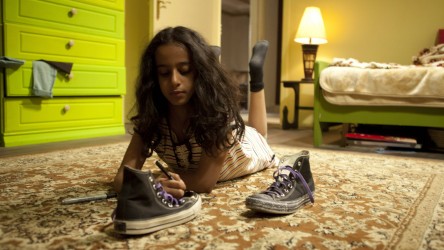Timbuktu(2014)
Thought-provoking drama exploring the effect of Islamist occupation in a remote city in West Africa.
Certificate
Age group15+ years
Duration94 mins


[SPOILER ALERT]
Sissako’s film is about sometimes deeply disturbing real events. The mixture in the film of beauty and brutality works to touch and mesmerize the viewer. The cow death scene is one main sequence where this can be observed. The slow descent into death we witness, the close up shots of her dying body, her eyes closing with the life fleeting, her legs that will never move again. The most significant sequence is the extreme close up shot of the blood dripping from her nose. This scene is a perfect example of beauty and brutality. It creates a beautiful image in death. This makes it more memorable and touching to a viewer, it grabs the eye and makes you want to look and observe the tragedy.
The cattle herder Kidane is waiting for his execution. His wife, Satima, appears and he leaps to get to her, resulting in both their deaths. The unity in death of husband and wife carries a beautiful sadness. We see a shot of them lying together on the sand floor, in an embrace. The viewer knows his death sentence is unjust. Kidane is a good man and does not deserve it. This scene carries the weight of their daughter, Toya, now being an orphan, both parents gone. The close-up shot of the Satima’s mouth, blood dripping out slowly, is a mirror to the same slow blood drop from the cow’s nose. It’s a reminder of another useless death as GPS had no need to die and nor did Satima. This may be seen as the end of the circle, the death of the cow started it and their death ended it.
Less heavy of a scene yet also very touching is the children playing football without a ball. It is a more light-hearted scene but the unfairness behind it makes it expressive. They are oppressed to the point that they use a pretend ball to play. It can show that no matter what, people will find a way, making the best of what they have. Their carefree and innocent play gives a touch of light to the heaviness of the situation. As a viewer this scene can be very effective today, as it’s a reminder of our own everyday life and how playing football being illegal and resulting in prosecution is something foreign to us.
Kidane killing the fisherman accidentally during their confrontation results in awful repercussions later on, yet it creates one of the most visually impressive scenes of the film. After the gun shot sounds there is a good sequence of silence and immobility, leaving the viewer in the unknown of whether both are dead. Once Kidane starts moving and realising what happened and the gravity of the situation we are then transported to an extreme long shot of the river/pond. In this extreme long shot we are met with the beauty of the desert they find themselves in, the colour palette full of yellows, oranges and beiges. Next is Kidane’s slow crawl away from the death he caused, as if escaping death. His walk across the water reminds one of Jesus walking across water. The fisherman crawls in the opposite direction before succumbing to his wound and Kidane escaping to the opposite direction is a poignant scene of life and death. As a viewer I felt very drawn into the scene; it stayed one of the most indelible in the film. We know Kidane just sealed his fate as he walks away.
The woman and man getting stoned to death uses cross-cutting back and forth, with the man simultaneously doing his movement dance. The pure brutal reality of the scene is reduced as we hear music over it; instead of the stones colliding with the victims' heads. This is a good example of the film’s mixing of beauty and pain. It lets the viewer see the reality through a veil of art.
An example of pleasure and pain is the young people being found singing, as their pleasure of music results in pain from punishing lashes. Quite remarkable is the woman still singing through her lashings, the pain of it being clear in her face, yet prevailing and still singing - an act of rebellion and freedom.
In conclusion, Timbuktu’s use of pleasure and pain/ beauty and brutality is an essential part of the film and makes the viewer appreciate the cinematography, yet puts into perspective the cruel reality of it all.
Print this review
Stream on Into Film+
A sweet and uplifting story about ten-year-old girl Wadjda who refuses to let the fact she's a girl stop her from doing the things she wants to do.
Certificate

This gripping story set in modern-day Iran offers up a universal drama and a compelling glimpse into everyday life in the troubled country.
Certificate

Documentary about a group of Iranian musicians which gives insight into everyday life in a Islamic fundamentalist state.
Certificate